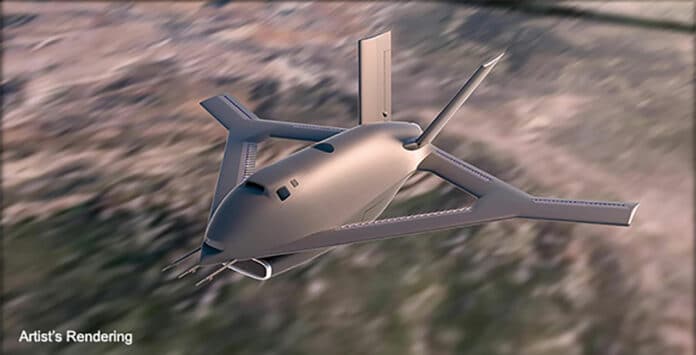DARPA has selected Aurora Flight Sciences to build a full-scale X-plane to demonstrate the viability of using active flow control (AFC) actuators for primary flight control that uses no external moving parts. The award is Phase 3 of the Control of Revolutionary Aircraft with Novel Effectors (CRANE) program.
The Wright brothers flew the world’s first fully controllable aircraft in December 1903. They used a technique called wing warping to achieve flight. Since then, virtually every aircraft has used a system of movable, external control surfaces – such as rudders, flaps, elevators, and ailerons – for flight control.
However, the X-65 breaks this century-old design paradigm. Instead of using movable external control surfaces, it uses jets of air from a pressurized source to shape the flow of air over the aircraft surface. This, along with AFC effectors on several surfaces that use an array of nozzles installed on the following edges of the airfoils, helps control the plane’s roll, pitch, and yaw. The elimination of external moving parts is expected to reduce weight and complexity, improving the aircraft’s overall performance.
“The X-65 is a technology demonstrator, and its distinctive, diamond-like wing shape is designed to help us maximize what we can learn about AFC in full-scale, real-world tests,” said Dr. Richard Wlezien, DARPA’s program manager for CRANE.
The X-65 will be built with two sets of control actuators – traditional flaps and rudders as well as AFC effectors embedded across all the lifting surfaces to manipulate the airflow around its wings and tail. The project aims to minimize risk and maximize the program’s insight into control effectiveness. The plane’s performance with traditional control surfaces will serve as a baseline; successive tests will selectively lock down moving surfaces, using AFC effectors instead.
“The X-65 conventional surfaces are like training wheels to help us understand how AFC can be used in place of traditional flaps and rudders,” said Wlezien. “We’ll have sensors in place to monitor how the AFC effectors’ performance compares with traditional control mechanisms, and these data will help us better understand how AFC could revolutionize both military and commercial craft in the future.”
Aurora Flight Sciences is fabricating the plane, which is set to be rolled out in early 2025, with the first flight planned for the summer of the same year. The X-65 will have a 30-foot wingspan, weigh over 7,000 pounds, and be capable of speeds up to Mach 0.7. Its weight, size, and speed – similar to a military trainer aircraft – make the flight test results immediately relevant to real-world aircraft design.
“We’re building the X-65 as a modular platform – wing sections and the AFC effectors can easily be swapped out – to allow it to live on as a test asset for DARPA and other agencies long after CRANE concludes,” said Wlezien.
The potential benefits of the AFC technology are enormous. If it proves to be successful, it could significantly improve aircraft design by reducing weight and simplifying systems. The resulting savings could be used to make airframes lighter and stronger, which could result in thinner and longer wings with improved efficiency. It’s even possible that one day, the technology could be expanded from airfoils to the entire aircraft, allowing it to be covered in a frictionless layer of air that would greatly reduce drag and make it more efficient.
“It’s thrilling to be able to say, ‘we’re building an AFC X-plane,” said Wlezien. “I came to DARPA in 1999 to work on a program called Micro Adaptive Flow Control, which helped pioneer the foundational understanding of fluid dynamics that eventually led to CRANE. I left DARPA in 2003 after managing MAFC, and it’s the chance of a lifetime to come back and help see that early work come to fruition in a full-scale physical aircraft. Aerospace engineers live to see their efforts take flight.”
